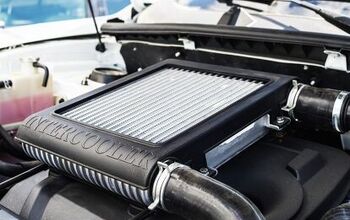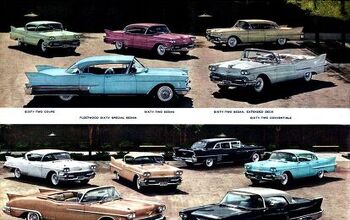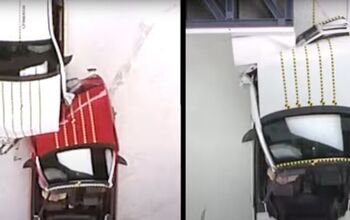Piston Slap: Hot Air on Frozen A/C Evaporators?

Sajeev, my old triple-black 1997 Town Car has developed some air conditioning problems and my trusted independent shop seems unable to duplicate it nor to understand it. Maybe you and the B/B can help?
The a/c always works when starting up the car but will abruptly cut out after a while, almost as if the clutch disengaged. This happens even when the system is fully charged. I was told by the technician to keep the fan blowing full speed but this merely delays the inevitable cutting out. There does not seem to be a refrigerant leak. Not being an air conditioning expert by any means, I am at a loss on how to proceed.
The car has only 170,000 miles on the meter and should be good for another 100,000. Not wanting to spend big bucks on replacing the entire system, where to start?
Sajeev answers:
This is a serious problem: please, quickly give me this fine dangerous Panther so that 1995-97 Town Car Fat Panther deliciousness can be mine! ALL MINE!
Okay, seriously: it could be incorrect refrigerant pressures, or possibly a blocked orifice tube. And while things like the A/C cycling switch and, in some vehicles, a Variable Control Relay Module can turn off the A/C Compressor’s clutch as you stated, the electronic bits might not be broken: they might be getting misleading information!
More to the point, the switching mechanism is freaking out because the evaporator froze, likely due to lack of airflow. Hence why you running the fan on MAX helped, somewhat.
What’s true for home HVAC applies here, as I noticed in 2009 when I ripped apart the dash to rebuild the HVAC (both hot and cold bits) in my 1988 Cougar. The Cougar was about as old (both age and mileage) as your Townie is now, hence why I am torturing you with the following story: this job was a nightmare because of personal/career issues, and because I was working in the mosquito-infested space you see below whenever I was lucid enough to turn a wrench!
And no, that blurry spot isn’t a fingerprint on the lens — it’s one of many bitter tears secreted when removing the HVAC box in a non-Mustang, non-Lincoln Fox Chassis vehicle that you just had to upgrade with nearly every factory option from donor cars in the junkyard. Because plug-and-play wiring (i.e. why we had a la carte options back then) was so damn easy to install, and you’re never gonna remove it and subsequently regret your decision, right?
Back on point: the heater core was my main issue, but I replaced the fan motor and evaporator. What I saw when removing the old evaporator was shocking: it was packed with dirt and leaves, apparently becoming a muddy mess over time. And that was likely due to the evaporator’s freezing/melting due to a lack of airflow.
Sure enough, the rebuilt HVAC box spewed painfully cold air during several blistering hot Houston summers. (Might need another clean now!)
I hope your evaporator isn’t as clogged as mine (was), but this job on a 1997 Town Car is likely much easier. And if A/C cleaners and smartphone linked endoscopes work as intended, you can inspect and then clean your evaporator without removing the dash.
Or just yank the dash: you know, for fun! It totally builds character, Son!
Send your queries to sajeev@thetruthaboutcars.com. Spare no details and ask for a speedy resolution if you’re in a hurry…but be realistic, and use your make/model specific forums instead of TTAC for more timely advice.

More by Sajeev Mehta
Latest Car Reviews
Read moreLatest Product Reviews
Read moreRecent Comments
- Turbo Is Black Magic My wife had one of these back in 06, did a ton of work to it… supercharger, full exhaust, full suspension.. it was a blast to drive even though it was still hilariously slow. Great for drive in nights, open the hatch fold the seats flat and just relax.Also this thing is a great example of how far we have come in crash safety even since just 2005… go look at these old crash tests now and I cringe at what a modern electric tank would do to this thing.
- MaintenanceCosts Whenever the topic of the xB comes up…Me: "The style is fun. The combination of the box shape and the aggressive detailing is very JDM."Wife: "Those are ghetto."Me: "They're smaller than a Corolla outside and have the space of a RAV4 inside."Wife: "Those are ghetto."Me: "They're kind of fun to drive with a stick."Wife: "Those are ghetto."It's one of a few cars (including its fellow box, the Ford Flex) on which we will just never see eye to eye.
- Oberkanone The alternative is a more expensive SUV. Yes, it will be missed.
- Ajla I did like this one.
- Zerofoo No, I won't miss this Chevrolet Malibu. It's a completely forgettable car. Who in their right mind would choose this over a V8 powered charger at the rental counter? Even the V6 charger is a far better drive.



































Comments
Join the conversation
My first thought is that the AC compressor clutch is failing. You can diagnose this two ways. One is to look at it while the engine is running and the AC set to 'max'. You should see the compressor clutch pull against the pulley and start to spin. If this doesn't happen in a 2 or 3 minute time frame, then you might want to look into the relay for the compressor clutch. This year of Town Car probably has an individual relay in a power distribution box, but it was common for Ford vehicles to have a relay module in which the relays are soldered onto a circuit board. If the compressor clutch is not cycling on then you need to diagnose the relay. The second way to diagnose the clutch is to measure the air gap while the engine is off. The gap between the clutch and pulley should not exceed .030". The compressor is probably the FS-10 compressor, which was very common in a lot of vehicles, and you can replace the clutch without replacing the entire AC compressor or having to open up the AC lines. You'll need a special tool, which will likely not fit, if your compressor clutch has 6 holes in the clutch plate - you'll have to use a lathe to reduce the diameter of the three cylinders to fit the holes of the compressor, or have a machine shop do that. You'll also need external snap ring pliers.
Why did he need to know it's "triple-black"?